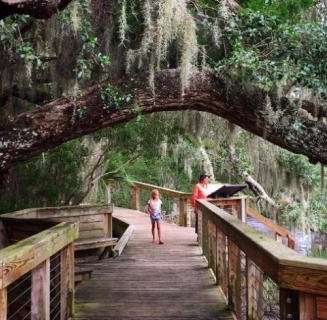
Spanish Moss: The True Story
Spanish moss hangs in silvery-gray strands from weathered live oaks. Newcomers are quick to ask: “Doesn’t that ‘fungus’ kill the tree? The short answer: no and no. Spanish moss is not a fungus (or a moss, for that matter!) and it doesn’t harm the tree. In fact, lacy plant just may be the key to the survival of coastal forests.
A well-traveled member of the pineapple family, Spanish moss (Tillandsia usneoides) ranges from coastal Virginia to Argentina. It is an “epiphyte,” or air plant that only hangs from branches to take in sunlight, rainwater, and nutrients in dust.
In the Lowcountry, Spanish moss flowers from April through July. On moist, warm evenings you may smell the delicate fragrance from very tiny blossoms. Late in summer, the three-petal flowers produce sliver-sized seedpods. These release seeds with downy hairs (think dandelion seeds, but way smaller). The aerial seeds float aloft until they strike a tree—usually a live oak, then slide off the waxy outer leaves, and finally settle in the fissures and crags of aging lower limbs. At this level, foliage is sparse and craggy dead branches are common. Here the moss grows, forming those showy festoons.
Live oak, black gum, and bald cypress trees have the most fissured bark and widest spreading, horizontal limbs. This is where you will see the Spanish moss strands. Palms are too bushy and pines too spindly-branched to support this plant.
MORE THAN A PRETTY LACE
In nature, nothing is useless and nothing goes to waste. This goes for Spanish moss too. Deer, wild turkeys and horses eat the delicate leaves. Many species of birds—bald eagle, osprey, red-shouldered hawk, owls, mockingbird, and many more use the moss as nest cushioning and insulation. Gray squirrels also fluff their nests with Spanish moss. And it’s those add squirrels that harvest acorns, bury those acorns, and promptly forget where those acorns are. Perhaps, if it weren’t for Spanish moss, the absent-minded squirrels wouldn’t have survived to plant the next generation of oak trees!
Gullah and coastal Indian healers brewed the leaves as tea to reduce fevers and for other pain remedies. Automaker Henry Ford also used the fluffy strands for cushioning and insulating the seats in the first Model-T Fords.
More Trending Stories

Hidden Gems of the Lowcountry
Beyond its pristine beaches and iconic landmarks, there’s a more secluded side to Hilton Head Island for those who prefer the roads, trails, and...

Embracing Nature in Hilton Head Island
As the summer gives way to the warm hues of autumn's soft tones, wildlife that typically lays low bursts back onto the scene. A haven for nature...

Finding Wellness on Hilton Head Island
Here on Hilton Head Island, wellness weaves through almost every activity and landscape. From the world-class golf courses and scenic cycling paths to...